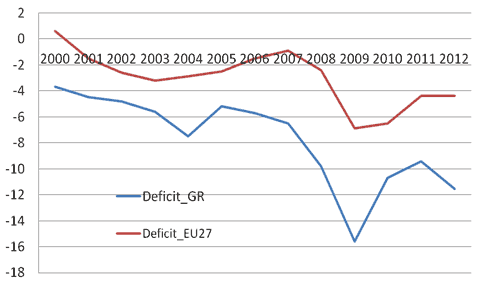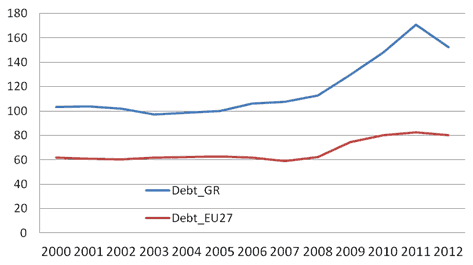The Greek governments had followed expansionary fiscal policies for many years. The government spending remained at high levels, chronic budget deficits continued, tax collection weakened, and public debt exceeded the size of the economy. The global economic crisis that started to take hold in 2008 exposed the structural weaknesses of the Greek economy. After the eruption of the debt crisis, Greece has embarked on an adjustment program, aimed at tackling the fiscal imbalances. As a result of this effort, Greece has experienced the largest fiscal consolidation among all countries of the Euro area. Given the state of the real economy, the fiscal consolidation, required to restore sustainable public finances, should rely on curtailing public expenditures and strengthening the tax collection, instead of further increasing taxes.
Current Situation
The Greek governments had followed expansionary fiscal policies for many years, which initially were financed by printing money and then by issuing Greek debt. The expansion of domestic demand generated an upward pressure in prices in non-tradable sectors. The increase in relative prices caused a reallocation of resources from tradable to non-tradable sectors, inducing an increase in labour costs and a subsequent loss in competitiveness, which resulted in external imbalances.
The current account deficit rose to 12.1 percent of GDP in 2012 and the net international investment position amounted to -92.5 percent of GDP in the same year. The global economic crisis that started to take hold in 2008 unveiled the chronic and structural weaknesses of the Greek economy. Apart from the external imbalances, the main economic problems of Greece were located in the sphere of fiscal imbalances, with the structural deficit approaching at 10 percent of GDP in 2008 and the public debt exceeding 110 percent of GDP that same year. Since 2010, Greece has embarked on an adjustment program, implemented with the technical and financial support of the International Monetary Fund, the European Union and the European Central Bank, which aimed at tackling the fiscal imbalances and setting the economy on the right track with growth and prosperity. The austerity program has relied on cutting wages and salaries, and increasing taxes.
As a result, the domestic demand has been severely decreased and the real economy has fallen in depression. The real GDP in constant prices was reduced from EUR 225.3 billion in 2009 to EUR 168.5 billion in 2012, which amounted to a reduction of about 25 percent, while unemployment jumped to 26 percent in the fourth quarter of 2012 from 10 percent in the corresponding period of 2009. On the fiscal front, the developments in the fiscal aggregates during the last twelve years are presented in Table 1 below. The data up to 2011 were obtained from Eurostat, while the data for 2012 were obtained from the Ministry of Finance.
The fiscal deficit was decreased from 9.4 percent of GDP in 2011 to 6.5 percent in 2012, while public debt was reduced from 170.6 percent of GDP in 2011 to about 152.6 percent of GDP in the third quarter of 2012, after a write down of the privately held Greek debt. The fiscal deficit in 2012 reflected a fall in revenues, on the one hand, and, on the other hand, a collapse in real output. The general government revenues were decreased from EUR 112.6 billions in 2011 to EUR 106.2 billions in 2012, while the total government expenditures (primary and interest payments) were decreased from EUR 133.3 billions in 2011 to EUR 118.8 billions in 2012. These changes reduced the general government deficit from EUR 20.6 billions in 2011 to EUR 12.5 billions in 2012.
In Table 2 below, we show the revenues accrued from direct and indirect taxes. On inspection, we observe that the indirect taxes accounted for the bulk of tax revenues in both 2011 and 2012.
| Year | Expenditures as % of GDP |
Revenues as % of GDP |
Fiscal Deficit as % of GDP |
Public Debt as % of GDP |
| 2012 | 61.3 | 54.8 | -6.5 | 152.6 |
| 2011 | 51.8 | 42.3 | -9.4 | 170.6 |
| 2010 | 51.5 | 40.6 | -10.7 | 148.3 |
| 2009 | 50.4 | 38.3 | -15.6 | 129.7 |
| 2008 | 50.6 | 40.7 | -9.8 | 112.9 |
| 2007 | 47.5 | 40.7 | -6.5 | 107.4 |
| 2006 | 45.3 | 39.2 | -5.7 | 106.1 |
| 2005 | 44.6 | 39.0 | -5.2 | 100.0 |
| 2004 | 45.3 | 38.1 | -7.5 | 98.6 |
| 2003 | 44.7 | 39.0 | -5.6 | 97.4 |
| 2002 | 45.1 | 40.3 | -4.8 | 101.7 |
| 2001 | 45.4 | 40.9 | -4.5 | 103.7 |
| 2000 | 46.7 | 43.0 | -3.7 | 103.4 |
| Source: Eurostat and Ministry of Finance (General Government Data, Monthly Bulletin, December 2012) | ||||
| TAXES | 2011 | 2012 | ||
| Direct taxes | 20,318 | 9.74% | 21,097 | 10.89% |
| Income tax Property taxes |
12,934 1,172 |
6.2% 0.56% |
13,311 2,857 |
6.87% 1.47% |
| Indirect taxes | 28,632 | 13.73% | 26,082 | 13.46% |
| Transaction taxes Consumption taxes |
17,790 10,131 |
8.53% 4.86% |
15,686 9,627 |
8.09% 4.97% |
| Source: Ministry of Finance | ||||
Tax Policy
According to Heritage’s 2013 Index of Economic Freedom, the overall tax burden in Greece in 2012 amounted to about 31 percent of GDP. The tax burden can be measured with several alternative indicators, including marginal and average personal tax rates. Marginal tax rates, which indicate the tax payable on additional earnings, affect incentives to increase work effort, while average tax rates levied on personal incomes may affect incentives to participate in the labour market. The statutory tax rates together with the tax base constitute the most important factors which determine the tax burden. In conjunction with statutory rates, other elements of the tax system contribute to the public finance. The main sources of the public revenues are the following:
+Personal income tax+
Since 2010, Greece has introduced an eight-bracket system, as a part of its fiscal consolidation strategy, which lasted until December 31, 2012. All types of income were unified and taxed based on the income tax scale with progressive tax rates ranging from 10 to 45 percent for income over EUR 100,000 (see Table 3). Since January 2011, a solidarity contribution has been imposed on all taxpayers with annual income exceeding EUR 12,000, with a progressive scale starting at 1 percent and rising to 4 percent for annual income over EUR 100,000. Thus, the top statutory tax rate on personal income amounted to 49 percent in 2012 and remained unchanged from the last year. The tax rate was above the European Union (EU-27) average of 38.1 percent and Euro area (EA-17) average of 43.1 percent. In 2011, the tax-free threshold was reduced from EUR 12,000 to EUR 5,000 and remained unchanged in 2012. The tax free allowance was given to taxpayers who had an annual income up to EUR 60,000 and collected receipts of living expenses covering at least 25 percent of the taxable income. If the collected receipts covered a smaller proportion of the taxable income, a tax of 10 percent was levied on the difference between the amount collected and the required amount.
The personal income tax system has been reformed with the law 4110/2013 which has brought profound changes to income taxation from every source. A three-tier system is introduced for employees and pensioners. The new tax scale imposes a tax rate of 22 percent on incomes up to EUR 25,000, a tax rate of 32 percent on incomes from EUR 25,001 to EUR 42,000 and a tax rate of 42 percent on higher incomes (see Table 4). A tax credit of EUR 2,100 is established and given in full to all employees and pensioners with annual income up to EUR 21,000. For higher incomes, the tax discount is reduced to EUR 100 per EUR 1,000 of income until the full amount is exhausted.
| Income scale (in euro) |
Tax rate (%) |
Scale tax (in euro) |
Income total (in euro) |
Tax total (in euro) |
| 5,000 | 0 | 0 | 5,000 | 0 |
| 7,000 | 10 | 700 | 12,000 | 700 |
| 4,000 | 18 | 720 | 16,000 | 1,420 |
| 10,000 | 25 | 2,500 | 26,000 | 3,920 |
| 14,000 | 35 | 4,900 | 40,000 | 8,820 |
| 20,000 | 38 | 7,600 | 60,000 | 16,420 |
| 40,000 | 40 | 16,000 | 100,000 | 32,420 |
| Over 100,000 | 45 | |||
| Source: Ministry of Finance | ||||
| Income scale (in euro) |
Tax rate (%) |
Scale tax (in euro) |
Income total (in euro) |
Tax total (in euro) |
| 25,000 | 22 | 5,500 | 25,000 | 5,500 |
| 17,000 | 32 | 5,440 | 42,000 | 10,940 |
| Over 42,000 | 42 | |||
| Source: Ministry of Finance | ||||
+Corporate income tax+
The statutory rate was cut from 25 percent in 2009 to 20 percent in 2010 and remained unchanged until December 31, 2012. At the same time, a special contribution at progressive rates was levied for enterprises with a net income above EUR 100,000. The top rate was 10 percent, thus increasing the top statutory tax rate on corporate income to 30 percent in 2012. This rate remained unchanged from the last year. The tax rate was above the EU-27 average of 23.5 percent and EA-17 average of 26.5 percent. With the new tax law 4110/2013, a progressive tax rate is imposed on private companies and self-employed (see Table 5). For the portion of income till EUR 50,000 the tax rate will be 26 percent and for higher incomes the tax rate will be 33 percent. The same scale is applied to General partnerships, limited partnerships, civil societies engaged in business or profession, civil or nonprofit companies, joint or invisible companies and joint ventures that do not maintain double-entry books. When the above maintain double-entry books, a tax of 26 percent is levied on their total net income. A tax of 13 percent will be levied on incomes earned from private agricultural businesses.
| Income scale (in euro) |
Tax rate (%) |
Scale tax (in euro) |
Income total (in euro) |
Tax total (in euro) |
| 50,000 | 26 | 13,000 | 50,000 | 13,000 |
| Over 50,000 | 33 | |||
| Source: Ministry of Finance | ||||
+Investment income tax+
A withholding tax of 25 percent was levied to dividends and distributed profits paid by enterprises in 2012. This rate was increased by 4 percent from the previous year. A withholding tax of 10 percent is levied to capital interest. The real estate income is taxed at 1.5 percent, which increased to 3 percent if the surface area of the property is greater than 300 square meters. With the new tax law 4110/2013, rental income as well as investment income, excluding income taxed at the source with no further tax liability, will be taxed at a rate of 10 percent up to EUR 12,000 and 33 percent for higher brackets. The tax rate on dividends and distributed profits will be reduced to 10 percent, the withholding tax on capital interest will be increased to 15 percent, and the withholding tax from derivative income will be increased from 15 to 20 percent.
+Value Added Tax and Excise duties+
The standard VAT rate, which applies to most goods and services, was 23 percent in 2012 and remained unchanged from the previous year. The tax rate was above the EU-27 average of 20 percent and EA-17 average of 21 percent. A reduced rate of 13 percent applies to certain goods and services, such as fresh food products, pharmaceutical, electricity, transportation, hospitality and other professional services. There also exists a super-reduced rate of 6.5 percent which applies to very few goods and services, such as books, newspapers and periodicals, and hotel accommodation services. In addition, specific rates of 5, 9 and 16 percent apply to some islands of the Aegean Sea. Excise tax rates are levied on mineral oils, beer, alcoholic beverages and tobacco, and have been increased repeatedly.
+Wealth tax/Property tax+
There is no a wealth tax in Greece. The taxation of properties was based on their objective value, determined by surface area, location and construction year. Based on the tax reform introduced with the law 3842/2010, a tax rate ranging from 0.2 to 1 percent was levied on properties from EUR 200,000 to EUR 5 million. The top rate was applied to real estate over EUR 800,000. For properties over EUR 5 million the rate was 2 percent. Since 2011, a real estate tax duty has been levied on residential property, calculated on the surface area of the buildings and taken into account location and age and is collected through the payment of electricity bills.
+Capital gains tax+
The capital gains realized from the sale of a business, a share in a business or business rights are taxed at 20 percent. A tax of 0.2 percent is also levied on the sale of shares traded on the Athens stock of exchange or on foreign exchanges. The tax rate on capital gains realized from properties purchased after 2006 depended on the holding period. With the new law 4110/2013, capital gains derived from the transfer of real estate acquired after January 1, 2013 will be taxed with a rate of 20 percent. The taxation will be computed on the difference between selling and buying prices. The capital gain will be deflated and adjusted with rates depending on the years of ownership of the real estate.
Budgetary policy
As we can see from Figure 1 below, the government deficit to GDP ratio in Greece was hovering between 4 and 6 percent until 2006, and then, as a result of expansionary fiscal policies, it was dramatically increased to over 15 percent of GDP in 2009. Thereafter, as a result of fiscal consolidation, it declined to an average of 11.5 percent of GDP in the first three quarters of 2012, but remained above the EU-27 average of 4.4 percent. Nevertheless, Greece has experienced the largest fiscal consolidation among all countries of EU-27. By inspecting Figure 2 below, we can see that the same story emerges from the government debt to GDP ratio. Until the middle of last decade, this ratio was fluctuating around 100 percent. Since then, it has started to increase substantially, reaching 170.6 percent in 2011. Greek government debt was reduced to 152.6 percent in the third quarter of 2012, thanks to the debt restructuring conducted over the course of the year. The picture which emerges from the budgetary adjustments can be characterized as the best change in 2012.

Figure 1: Government deficit to GDP ratio, in percent

Figure 2 : Government debt to GDP ratio, in percent
Conclusions
Fiscal policy in Greece has paved the way for the current economic crisis. For many years government spending remained at high levels, chronic budget deficits continued, tax collection weakened, and public debt exceeded the size of the economy. In the aftermath of the debt crisis, Greece has embarked on economic reforms in order to bring its public finance on a sustainable path and set the economy on the right track with growth and prosperity. Given the collapse of real output and soaring unemployment, the stabilization of the real economy, in the context of fiscal consolidation, should rely on curtailing public expenditures and strengthening tax collection, instead of further cutting wages and salaries, and increasing taxes. In addition, structural reforms are required to open production and labour markets, eliminating the rampant tax evasion in the private sector, improve investment climate and increase productivity, thus increasing real incomes and economic welfare.
Costas Karfakis
Department of Economics, University of Macedonia
School of Social Science, Hellenic Open University






1 comment
Greece government spending
I read that 80% of the Greek budget goes to bureaucrat compensation and pensions. The source is not reliable, also I woudl like to know if you could help me find out if it is true. Thank you.